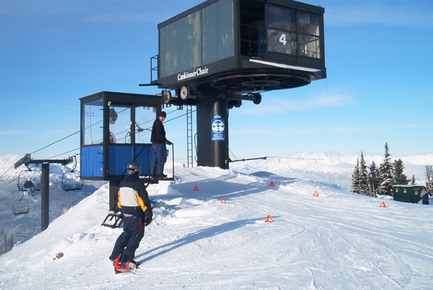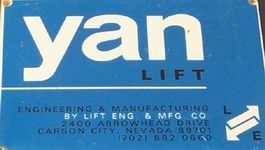Lift Engineering
|
|
Lift Engineering, more commonly known simply as Yan, was one of the major ski lift manufacturers in North America, before the firm's bankruptcy in 1996.
The company built at least 200 fixed-grip chairlifts, as well as 31 high speed quads, while becoming one of the most controversial lift firms in the ski industry- YAN fixed-grip chairlifts have an excellent reputation, while the company's high speed quads have killed five people.
Jan Kunczynski, a Polish immigrant and former ski racer founded Lift Engineering in 1965, after leaving Poma to build his own ski lifts. One of his first customers was Squaw Valley, California.
The name "Yan" is the brand Mr. Kunczynski sold his lifts under. It is the English spelling of his first name, Jan.
The company grew through the 1970s and 1980s, mostly because of Mr. Kunczynski’s good salesmanship. Rather than merely negotiate with buyers, Mr. Kunczynski shared his visions over apres ski meals by sketching them on paper napkins. Another attractive feature to buyers was the price. Mr. Kunczynski sold his lifts at prices well below those of larger manufactuers.
Mr. Kunczynski is also credited with being the first manufacturer of ski lifts to incorporate aesthetics into the design of his equipment, creating sleek designs that were popular with ski resorts.
By the late 1980s, Lift Engineering was the one of the largest suppliers of ski lifts based in North America.
The company is most noted for its achievements in designing fixed-grip chairlifts. Mr. Kunczynski created a standard system that served the company well. The design is always simple and easy to operate and maintain. For example, rather than put all the control panels in the operator's booth, and thus potentially confuse whoever is operating the lift, Yan operator booths contain only two switches: a switch that stops and starts the lift, and one that selects how fast it goes. The other controls were placed in the standard shipping crate-reminiscent engine room. Finally, besides being easy to operate, Yan lifts are also easy maintain- the setup is reputedly foolproof. Yan's tower designs were also always overbuilt, meaning that it is possible to turn one of his triple chairs into a fixed quad merely by changing the chairs (this was actually done at Killington, Vermont).
 |
| An example of a Yan triple chair |
Potential problems with Yan lifts began to surface as early as 1985, when the upper bullwheel on the Teller lift at Keystone, Colorado literally fell off its axle. Faulty welding was blamed. Two people were killed and 47 injured. The lift was rebuilt by Yan as the Ruby lift- presumably free of charge.
During the late 1980s, the Colorado Tramway Board began to question the safety of Yan’s lifts. It surfaced that Mr. Kunczynski, in his drive to build affordable ski lifts, regularly sent steel parts to be welded together in ski area parking lots. The Board alleged that Mr. Kunczynski’s lifts were completely unsafe- which is debatable. The ski industry blasted the Board and continued to install Yan lifts. Nevertheless, the board continued protesting and managed to keep Yan detachable quad lifts out of Colorado.
Lift Enginneering plunged head first into a new market in 1986, the high-speed detachable quad lift. Whereas the European ski lift firms spent upwards of two years developing these lifts, Yan installed its first in 1987, at Mammoth, California.
Unfortunately, Les Ogalik, the company’s chief engineer who was responsible for making sure Mr. Kunczynski’s innovations were safe, quit during the development of the detachable lift. Les Ogalik is now president of POL-X West, an engineering firm.
| Missing image Yantriple.JPG image:Yantriple.JPG |
| Towers and chairs on a Yan triple lift. |
The only Yan high-speed lift ever installed in Colorado was a gondola lift at Keystone, which only operated for two years because of recurring mechanical problems. Indeed, Yan only built two gondolas- the other was at Squaw Valley, California, and also had recurring problems.
Despite questions about safety, Yan managed to sell a total of 31 high-speed quads in the United States and Canada. Loyal customers unfortunately learned later that the lifts were riddled with mechanical quirks and problems, and were unsafe.
Yan detachable lifts were subject to a series of disastrous accidents, the most famous of which was on the Quicksilver lift at Whistler-Blackcomb Resort in British Columbia, Canada. The Quicksilver accident killed two and injured 70. The Quicksilver lift is also notable for being one of the few- and possibly the only- Yan quad lift that had bubble chairs.
The main problems with the Yan high-speed lifts were the chair grips. These were designed so that in order to stay connected to the cable, the chair had to be subject to gravity. The grips, unlike most operating today, did not have high-tension coil springs, but rather rubber Marshmellow springs that exerted much less force on the cable. The emergency brake firing was enough to shake the chairs free of the cable.
| Missing image Yanquad.jpg image:Yanquad.jpg |
| An example of a later model Yan high-speed quad lift |
Unfortunately, the majority of state lift inspectors were complacent in detecting these problems. It has been proven that the Government of British Columbia knew about the problems on the Quicksilver lift, and refused to do anything about it.
All 31 Yan high-speed quads have either been retrofitted or torn down.
POL-X West developed a new version of the YAN-7 detachable grip (the one that was used on the majority of the high-speed lifts) that replaces the Marshmellow springs with high-tension springs. The re-design was ordered by a group of BC and Alberta ski resorts that included Silver Star and Lake Louise. The new 7-96 grip was only ultimately installed on one lift: the Friendly Giant at Lake Louise, and two other lifts at Silver Star.
Lift Engineering also dived headlong into another market in the early 1990s- the funitel. The quad mono cable or QMC funitel was invented by Mr. Kunczynski himself (US Patent 4,848,241). The lift consisted of four separate loops of cable, strung between the upper and lower stations. Two cables were run in the uphill direction, and two were run in the downhill direction. The cabins would be mounted between the cables. But, because the cables were looped, once the cabins reached the upper station, the cables would loop back downhill not carrying a load. Only one of these lifts was ever built, at June Mountain, California. Apparently, the owners had quite a time getting the cables to run synchronized. The lift also developed the grip problems that occurred on the Yan high-speed quads, and was removed in 1997.
It is entirely possible that these problems stem from the design of the detachable lift being fast-tracked in order to speed development.
Lift Engineering filed for bankruptcy in 1996, after the Quicksilver accident.

